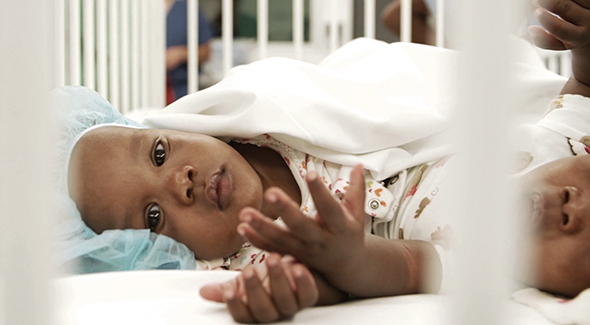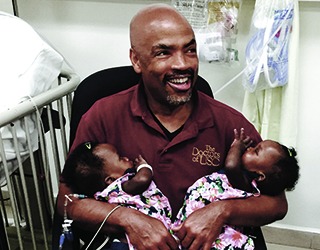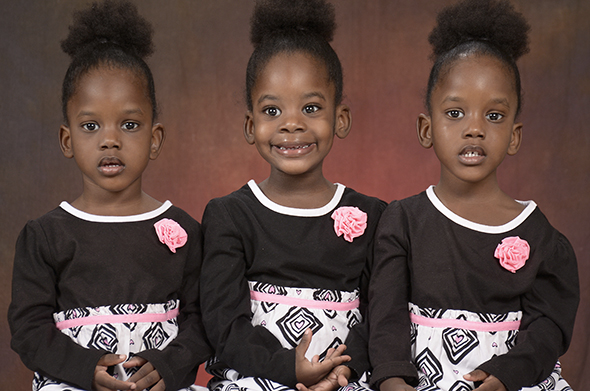A native son, two brothers, and three little girls
Summer 2018

In November of 2014, David Bernard sat with his wife, Manoucheca Ketan, in the modern Mirebalais University Hospital (Hôpital Universitaire de Mirebalais), which is situated on a patch of flatland in rural, central Haiti.
After carrying triplets for 36 weeks, Ketan was recovering from the C-section needed to deliver her three daughters. Tamar was born healthy and separate. Michelle and Marian were conjoined and “omphalopagus,” connected at the abdomen, facing each other.
When the ultrasound showed three babies, the mother was stressed. When diagnosed with conjoined fetuses, she kept asking herself, “How will I deal with it?”
Some Haitian folklore casts conjoined siblings as cursed. A prevailing myth is that the births are punishment from the gods; the stigma can cause parents to struggle to accept the children. Often, they are left to die.
For two weeks, Ketan refused to see or hold her conjoined daughters. She was hesitant to bond with them and not sure she ever could.
“Disabled people are not valorized in Haiti,” she said recently from her hilltop home in Pétionville, a suburb of Haiti’s capital, Port-au-Prince.
If her babies could not be separated, she wondered, “How could they go to school, and how would they make it day by day?”
“If I’m their mother, and I am having these doubts,” she kept asking herself, “what about society? How will society not [see] them as being monsters?”
Not long after their birth, Henri Ford (Fel ’89, ’93), the vice president and surgeon in chief at Children’s Hospital Los Angeles, was called to come see the family. To connect on a more personal level, he spoke with them in Haitian Creole, the lyrical dialect that mixes French, African, and indigenous speech. He told the parents the babies were precious and that he was confident the girls could be separated.
He assured the family that even though the rare and complex operation to separate the girls would take place in a nation severely strained by inadequate medical infrastructure, their little bodies could still become two. They could lead independent lives.
***
Ford is a son of Haiti. Though he is now the newly appointed dean of the University of Miami Leonard M. Miller School of Medicine, he grew up in Port-au-Prince, near Carrefour Feuilles, a district of French colonial homes and a hub for the intellectual class. From his childhood home, he could walk to the national seminary, the national stadium, and the medical school of Haiti.
Every morning, the young Ford listened to the radio. It’s where he learned the fundamentals of diseases such as malaria and smallpox. He liked science, and the radio programming was his introduction to public health and medicine.
Ford’s father, an activist minister, spoke out against the policies of Haitian dictator François “Papa Doc” Duvalier. In 1972, the family fled to the United States for safety. They settled in Brooklyn, N.Y. Ford was 13.
At first, Ford felt like an outsider in America; he struggled with English, and his schoolmates ostracized him for being different. He eventually excelled. He was accepted into Princeton and then Harvard Medical School. He came to the University of Pittsburgh, where he completed a research fellowship in immunology (1987–89) in the Department of Surgery and a clinical fellowship (1991–93) in pediatric surgery at Children’s Hospital of Pittsburgh of UPMC. For several years, he stayed on at Pitt, eventually becoming chief of pediatric surgery. He left Pittsburgh when he felt called to tend to a population with a greater need in East L.A.
He was working in California when the 2010 earthquake struck Haiti, killing an estimated 300,000 people. Wracked by images he saw on television of children homeless and desperate amid the rubble, Ford raced to Haiti the second day after the airport opened. He cared for people in hospitals set up in fields. In the years since he left Haiti, he’d only returned three times. He now travels there four to five times a year.
“I do this out of a sense of duty and to try to make a difference in strengthening the health care infrastructure.”
He is now convinced that if 10 percent of the Haitian diaspora—especially the engineers, computer scientists, biologists, and other professionals who are scattered around the world—would commit to doing something for Haiti, conditions in the country would be vastly different.
“Haitians are tenacious,” he says. “We can’t just come over once and be done. We have to come back and build sustainability.”
Ford works closely with the teaching hospital in Mirebalais and with the 50-bed Bernard Mevs Hospital. They are two of the top hospitals in Haiti and regularly provide pediatric surgical care. Bernard Mevs, in Port-au-Prince, even has pediatric and neonatal care units and a residency program; it offers trauma care, critical care, and rehabilitation.
A few months after the 2010 earthquake, Ford met the Bitar brothers. The Bitars are identical twins and surgeons at Bernard Mevs, and their drive to advance medicine in Haiti is as intertwined as their DNA. They perform surgeries together. They share an e-mail account. They often don’t distinguish themselves by using their first names. “Please,” they say, “we are simply the Docteurs Bitar.”
They call Ford their brother and get emotional describing the imprint that he has made on Bernard Mevs and the larger Haitian medical universe. During a week at Bernard Mevs or another hospital, Ford will perform surgery and teach. He often brings a team with him; those physicians, nurses, and anesthesiologists are focused on advancing care for infants and children.
Before Ford’s regular consultations at Bernard Mevs, the staff was overwhelmed by some pneumonia cases in infants. Ford taught the doctors procedures to clear the lungs; then the babies started going home after a few days.
To whom much is given, much is required, Ford tells the staff. Keep learning, he says, because it’s a way to rise above mediocrity, frustrations regarding the lack of equipment, and other obstacles.
“God brings him back so that we can go far, far, far,” say the Docteurs Bitar. “He is like oxygen for us.”
Sure, Ford brings compassion. He once came on 24-hour notice for a case. He once postponed an important meeting in California to stay in Haiti and assist with a procedure on a sick baby.
But he also brings the international training to build competency, infrastructure, and critical skills. He invites residents from other Haitian hospitals to observe and practice.
“Partnership is important,” says Ford. “We’re not itinerant,” he says of his team. “We don’t do surgical tourism. We come to Haiti to improve health care outcomes and build surgical capacity.”
Before Ford, the Docteurs Bitar and the staff at Bernard Mevs tended to take on less complex pediatric surgeries: hernia, lipoma, hydrocele, gastrostomy. And when they tried more complicated procedures to correct newborn surgical emergencies such as intestinal atresia, abdominal wall defects, or Hirschsprung’s disease, the children often died because the hospital didn’t have the equipment to resuscitate or the wherewithal for proper aftercare.

Routinely now, seven years after Ford began bringing in equipment and specialists to provide training and protocols to Bernard Mevs, the Docteurs Bitar and other surgeons there have been able to manage difficult pediatric operations such as reconnecting intestinal perforations, removing obstructions in the gastrointestinal tract, and repairing congenital anomalies in the lower intestines.
In 2014, Haitian physicians performed 1,475 complicated procedures at Bernard Mevs; 595 of them were on patients younger than 18 years old. The majority of these procedures have been
successful. Before and in the aftermath of the
earthquake, such feats would have been impossible.
***
Marian and Michelle were 6 months old when Ford began leading preparations for surgical separation.
Little is ordinary about their case. Conjoined newborns occur once in every 200,000 live births worldwide. (More than half of all conjoined siblings are stillborn.) Omphalopagus twins represent 30 percent of those births. Rarer still, conjoined siblings within a triplet pregnancy occur in fewer than one in a million deliveries. More generally, mothers in Haiti are 12 times more likely to die giving birth than mothers in the United States. So, just by surviving their birth, Marian and Michelle beat the odds.
Still, they were attached by their livers and a fused xiphoid process, the breastbone in the lower portion of the sternum. The girls did not share a pelvic attachment, which meant the surgery required for separation was not as complicated as it would have been for some conjoined siblings. Nevertheless, the procedure, considered a massive undertaking at any hospital, had never been attempted in Haiti.
Ford assembled a crew that included the Docteurs Bitar and 16 other U.S. and Haitian surgeons, nurses, respiratory therapists, intensivists, anesthesiologists, and ob/gyn specialists. Each week, teams in Haiti monitored the girls’ progress and teleconferenced with their U.S. colleagues to discuss equipment, procedures, and logistics. The yellow team looked after Michelle, and the red team attended to Marian. On May 22, 2015, shortly after 1 p.m., Maclee Jean-Louis, Mirebalais University Hospital’s chief of surgery, made the first incision toward separation.
Early on, the teams encountered episodes of cross circulation: When the surgeons gave Marian blood, medication, or another fluid, she quickly passed it through her liver, sending the benefits to her sister.
The teams remedied that issue by quickly separating the liver and hydrating the girls individually. As the procedure went along, the girls needed to be resuscitated, an ovarian cyst was removed in Michelle, and both girls’ abdominal walls were reconstructed. The teams built them belly buttons.
After seven hours, Ford had successfully led the first separation of conjoined siblings in Haiti.
That night Michelle and Marian slept in separate cribs. Twenty-four hours later, their parents held them. In three days, the girls were eating. Nine days after that, they were discharged.
The news was widely reported. The first lady of Haiti and the nation’s minister of health visited the family. Once, a mother feared her society would reject her babies; now her daughters are symbols of national pride.
The girls are seen as miracles. Michelle and Marian needed rehab to strengthen their spines and stand straight. But they walked before their sister, Tamar.
Ford has kept in touch with the family. He gave the sisters vaccinations. He speaks with them on the phone. This past Christmas, the Bernards videotaped the triplets singing a message to the doctor in front of a decorated tree. (Catch them caroling here.)
Their development and growth are emblematic of the progress that Ford believes teamwork and increased medical infrastructure can bring to Haiti.
This January, the Bernard family celebrates the father’s birthday in their sunny dining room in Pétionville. His three little girls enter in red shirts and blue pants, their pint-sized Afros sitting like crowns upon their heads.
A little later, their mother will join them from the kitchen and hug each girl warmly. She’ll sit down and place Tamar and Michelle on her knees while Marian, the most introverted of the three, slides behind her back.
But first, Tamar, Michelle, and Marian, now 3 years old—healthy, happy—one by one walk up to their father and kiss him in celebration. Gifts from Dr. Henri Ford and friends.

